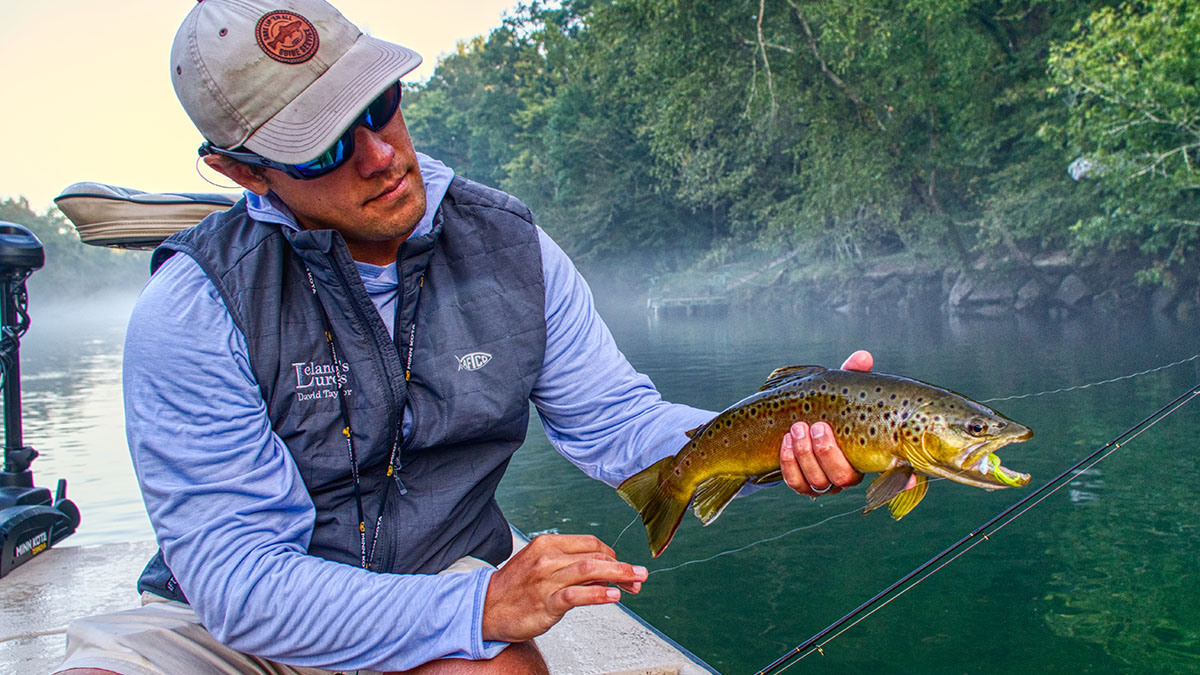There’s something special about trout fishing in the mountain waters off Colorado. Crisp mornings, crystal-clear rivers, and smart and pressured trout that make you work for every bite. On a recent trip to the South Platte River, I spent a few days dialing in three highly effective ways to fish trout jigs in western waters: float fishing, twitching and jigging. Each one shines under different conditions—and together, they’ll help you catch more trout no matter where you fish.
1. Float Fishing – A Natural Drift That Trout Can’t Resist
Float fishing is all about presenting your bait naturally in the current. It’s a bit like eating at a Brazilian steakhouse—when you flip your coin to the green side, the servers keep bringing food your way. The trout you catch out west on the float have that coin flipped to green—they’re ready for more of what the river brings drifting by.
The key is to drift your jig through the feeding lanes. I cannot emphasize this enough when it comes to wild trout. In the highly pressured waters of the South Platte River, EVERY CAST is intentional and has a strategy behind it. Cast upstream and let the float carry your bait naturally along seams, drop-offs, or behind boulders. These are the places trout hold—right on those transitions between shallow and deep water. Undercut banks, boulders, and small depth changes in the channel are your friends here.
Use light gear for this technique: 2-pound Phantom fluorocarbon leader and a small float like the E-Z Trout Float. The lighter setup helps your presentation look natural and subtle. Good bait choices include the Trout Magnet (1/64 ounce), Tungsten Trout Magnet jighead (1/32 ounce), or the hand-tied Mop Drop. Keep your depth dialed in so your bait drifts just above the bottom—most fish won’t move far up to feed on something like the trout magnet.
Pro Tip: Start shallow and gradually increase depth until you start getting bites or hitting bottom. Go deep or go home—if you aren’t fishing at the right depth, you might as well go home.

2. Twitching – Trigger Strikes from Curious or Lazy Fish
When the bite slows or fish are visible but not feeding, it’s time to switch to twitching. This method targets those stubborn trout you can see sitting in the current. You’re not trying to mimic a specific insect or baitfish—you’re trying to provoke a reaction rooted in curiosity, convenience or simply annoyance.
Use a light jig like the Trout Magnet or Tungsten Trout Magnet, tied to 2-pound fluorocarbon leader. Cast across the current, then make small, rhythmic twitches with your rod tip. The goal isn’t to make the jig jump, but to make it quiver—almost like a bug struggling in the water.
Polarized sunglasses are essential so you can spot fish and watch how they react. If they follow but don’t bite, change colors. Bright shades like white or chartreuse are great starting points because you can easily track them in the water. Once you find a color that triggers bites, remember it—you can use that same color later when float fishing.
Pro Tip: Twitching is a finesse technique best used in clear, relatively calm water. Be patient and observant—the first clue that you’ve got the right color or motion is how the fish behave.

3. Jigging – Cover Water and Find Aggressive Fish
When the wind picks up or clouds roll in, break out your heavier jigs and start covering water. Jigging is a search technique—you’re not hunting individual fish, you’re hunting reactions. It’s perfect for windy afternoons or when pressure is on the way down.
Try 1/16 or 1/8-ounce D2 Jigs in colors like white, peaches, or Toad-O (an olive sculpin imitation). Cast across the current and let it sink near the structure, then pop or sweep your rod tip to make the jig dart side-to-side near the bottom. This triggers strikes from bigger, more aggressive trout that see the jig as a meal they can’t ignore.
For this approach, use a slightly heavier setup—4-pound fluorocarbon leader and braid mainline—and a longer rod like the 8-foot Trinity Rod for better line control. Focus on undercut banks, deep runs and boulder pockets where fish can ambush prey.
Pro Tip: Don’t let fear of losing a jig keep you from fishing close to the structure. Big trout live where most anglers won’t cast.

Putting It All Together
Each of these techniques, float fishing, twitching and jigging, have their time and place. Float fishing excels in fast seams and dropoffs. Twitching shines when the water is clear, sun is high, and fish are visible but hesitant. Jigging is your go-to when the wind blows, weather changes, and you want to trigger the predator instinct.
If you want to master Colorado waters, learn all three. Practice reading current, adjusting depth, and varying retrieve speed. Soon you’ll find yourself catching more fish and enjoying the process more along the way.
So grab your rod, head to your favorite river, and give these techniques a try. Every drift, twitch and jig is a chance to learn, and maybe, you will even hook that fish of a lifetime.
God bless, and sore lip ‘em!




